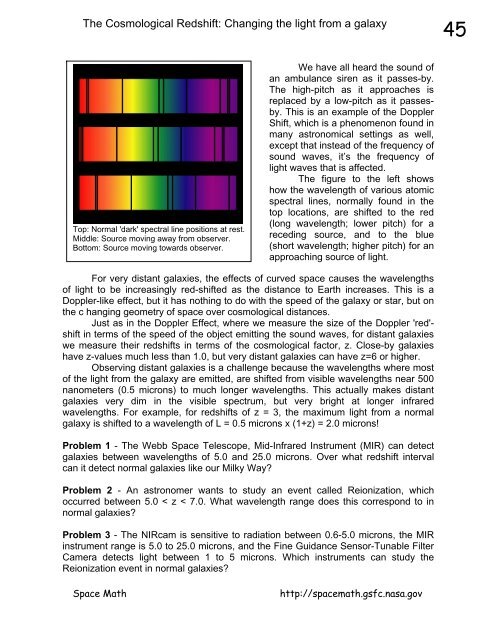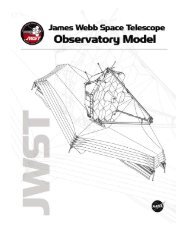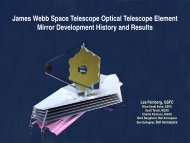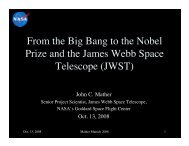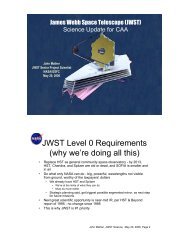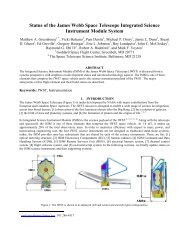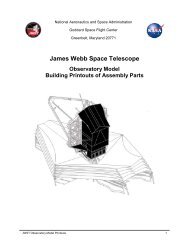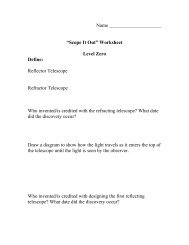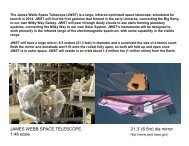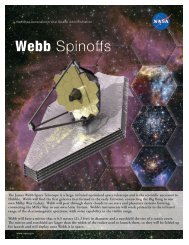The Cosmological Redshift - James Webb Space Telescope - NASA
The Cosmological Redshift - James Webb Space Telescope - NASA
The Cosmological Redshift - James Webb Space Telescope - NASA
Create successful ePaper yourself
Turn your PDF publications into a flip-book with our unique Google optimized e-Paper software.
<strong>The</strong> <strong>Cosmological</strong> <strong>Redshift</strong>: Changing the light from a galaxy<br />
45<br />
Top: Normal 'dark' spectral line positions at rest.<br />
Middle: Source moving away from observer.<br />
Bottom: Source moving towards observer.<br />
We have all heard the sound of<br />
an ambulance siren as it passes-by.<br />
<strong>The</strong> high-pitch as it approaches is<br />
replaced by a low-pitch as it passesby.<br />
This is an example of the Doppler<br />
Shift, which is a phenomenon found in<br />
many astronomical settings as well,<br />
except that instead of the frequency of<br />
sound waves, it’s the frequency of<br />
light waves that is affected.<br />
<strong>The</strong> figure to the left shows<br />
how the wavelength of various atomic<br />
spectral lines, normally found in the<br />
top locations, are shifted to the red<br />
(long wavelength; lower pitch) for a<br />
receding source, and to the blue<br />
(short wavelength; higher pitch) for an<br />
approaching source of light.<br />
For very distant galaxies, the effects of curved space causes the wavelengths<br />
of light to be increasingly red-shifted as the distance to Earth increases. This is a<br />
Doppler-like effect, but it has nothing to do with the speed of the galaxy or star, but on<br />
the c hanging geometry of space over cosmological distances.<br />
Just as in the Doppler Effect, where we measure the size of the Doppler 'red'-<br />
shift in terms of the speed of the object emitting the sound waves, for distant galaxies<br />
we measure their redshifts in terms of the cosmological factor, z. Close-by galaxies<br />
have z-values much less than 1.0, but very distant galaxies can have z=6 or higher.<br />
Observing distant galaxies is a challenge because the wavelengths where most<br />
of the light from the galaxy are emitted, are shifted from visible wavelengths near 500<br />
nanometers (0.5 microns) to much longer wavelengths. This actually makes distant<br />
galaxies very dim in the visible spectrum, but very bright at longer infrared<br />
wavelengths. For example, for redshifts of z = 3, the maximum light from a normal<br />
galaxy is shifted to a wavelength of L = 0.5 microns x (1+z) = 2.0 microns!<br />
Problem 1 - <strong>The</strong> <strong>Webb</strong> <strong>Space</strong> <strong>Telescope</strong>, Mid-Infrared Instrument (MIR) can detect<br />
galaxies between wavelengths of 5.0 and 25.0 microns. Over what redshift interval<br />
can it detect normal galaxies like our Milky Way?<br />
Problem 2 - An astronomer wants to study an event called Reionization, which<br />
occurred between 5.0 < z < 7.0. What wavelength range does this correspond to in<br />
normal galaxies?<br />
Problem 3 - <strong>The</strong> NIRcam is sensitive to radiation between 0.6-5.0 microns, the MIR<br />
instrument range is 5.0 to 25.0 microns, and the Fine Guidance Sensor-Tunable Filter<br />
Camera detects light between 1 to 5 microns. Which instruments can study the<br />
Reionization event in normal galaxies?<br />
<strong>Space</strong> Math<br />
http://spacemath.gsfc.nasa.gov
Answer Key 45<br />
Problem 1 - <strong>The</strong> <strong>Webb</strong> <strong>Space</strong> <strong>Telescope</strong>, Mid-Infrared Instrument (MIR) can detect<br />
galaxies between wavelengths of 5.0 and 25.0 microns. Over what redshift interval<br />
can it detect normal galaxies like our Milky Way?<br />
Answer: L = 5.0, so 5.0 = 0.5 x (1+z) and so z = 9.0<br />
L = 25, so 25 = 0.5 x (1+z), and so z = 49.0<br />
<strong>The</strong> redshift interval is then z = [9,49]<br />
Problem 2 - An astronomer wants to study an event called Reionization, which<br />
occurred between 5.0 < z < 7.0. What wavelength range does this correspond to in<br />
normal galaxies?<br />
Answer: Z=5.0 corresponds to L = 0.5 x (1 + 5) so L = 3.0 microns<br />
Z = 7.0 L = 0.5 x (1 + 7) = 4.0 microns.<br />
Problem 3 - <strong>The</strong> NIRcam is sensitive to radiation between 0.6-5.0 microns, the MIR<br />
instrument range is 5.0 to 25.0 microns, and the Fine Guidance Sensor-Tunable Filter<br />
Camera detects light between 1 to 5 microns. Which instruments can study the<br />
Reionization event in normal galaxies?<br />
Answer: <strong>The</strong> Reionization event can be detected between 3.0 and 4.0 microns ,which<br />
is within the observing ranges of both the NIRcam and the FGS-TFC instruments, but<br />
not the MIR camera.<br />
Note: <strong>The</strong> Reionization event is believed to be the result of an intense period of<br />
supernova activity in millions of galaxies across the universe, which caused intense<br />
amounts of ultraviolet radiation sufficient to ionize hydrogen gas clouds. <strong>The</strong> first time<br />
the universe was ionized to this degree ended about 400,000 years after the Big Bang<br />
when the universe cooled down during its expansion. <strong>The</strong> term 're' ionization indicates<br />
that the expanding cooled hydrogen gas clouds once again became ionized about 100<br />
million years after the Big Bang in a second ionization event.<br />
<strong>Space</strong> Math<br />
http://spacemath.gsfc.nasa.gov


